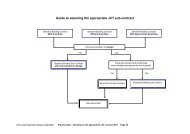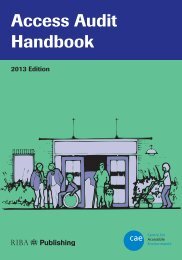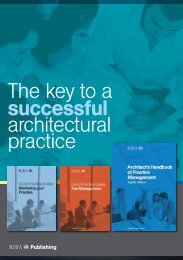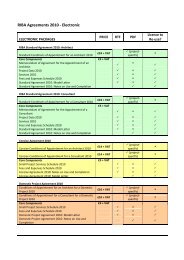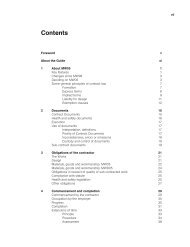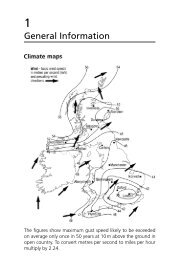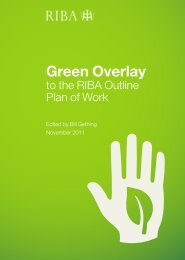PART 3 HANDBOOK - RIBA Bookshops
PART 3 HANDBOOK - RIBA Bookshops
PART 3 HANDBOOK - RIBA Bookshops
You also want an ePaper? Increase the reach of your titles
YUMPU automatically turns print PDFs into web optimized ePapers that Google loves.
<strong>PART</strong> 3<br />
<strong>HANDBOOK</strong><br />
STEPHEN<br />
BROOKHOUSE
<strong>PART</strong> 3<br />
<strong>HANDBOOK</strong><br />
CONTENTS<br />
FOREWORD<br />
ACKNOWLEDGEMENTS<br />
INTRODUCTION<br />
v<br />
vi<br />
vii<br />
1 PREPARING FOR <strong>PART</strong> 3 1<br />
The professional architect 1<br />
The ARB and the <strong>RIBA</strong> 4<br />
The Part 3 Criteria 10<br />
Skills 12<br />
Refl ective practice: learning from experience and professional development 13<br />
The role of practice in preparing for Part 3 14<br />
Choosing a Part 3 provider 15<br />
2 PROFESSIONAL DEVELOPMENT: LEARNING FROM EXPERIENCE IN THE<br />
WORKPLACE AND THE PEDR 18<br />
Part 3 professional experience: the documentation 21<br />
Summary 30<br />
3 WRITTEN EXAMINATIONS 33<br />
‘Why use written examinations in the context of a professional assessment?’ 33<br />
The different types of written examination 34<br />
Dispelling myths about written examinations 36<br />
What makes a bad answer 38<br />
Examination technique 38<br />
Critical success factors 39<br />
Typical examination question formats 45<br />
Types of question and how to answer them 49<br />
Putting these ideas into practice – some sample examination questions and<br />
answers 54<br />
Conclusions 103<br />
4 THE CASE STUDY 105<br />
The role of the case study in the Part 3 examination 105<br />
Getting started 106<br />
Frequently raised issues 108<br />
Confi dentiality 116<br />
Negotiation, ownership and time management 116<br />
Case study structure 117<br />
Length of study 119<br />
Looking at each section in detail 120<br />
iii
A wider perspective 133<br />
Good practice 134<br />
Some case study myths 135<br />
Conclusions 138<br />
5 THE ORAL EXAMINATION 140<br />
The role of the interview 140<br />
‘Why use an interview format?’ 140<br />
Format of the interview 144<br />
‘Where do examiners come from?’ 146<br />
‘What benchmarks do examiners use?’ 147<br />
‘Why do interviews seem to vary?’ 148<br />
Typical questions and strategies for answering them 148<br />
Preparing for the interview 154<br />
The end of the interview 156<br />
Key points about the interview 156<br />
What happens if you fail? 157<br />
Myths and legends 158<br />
Conclusions 158<br />
6 AFTER <strong>PART</strong> 3 161<br />
Registration 161<br />
Professional membership 162<br />
Continuous Professional Development 163<br />
Further professional development 163<br />
Taking on further responsibility 164<br />
The changing profession 164<br />
NOTES 167<br />
APPENDICES<br />
1 The Part 3 Criteria 2010 174<br />
2 Useful sources and links 179<br />
3 Schools of Architecture offering Part 3 in the UK and other providers (<strong>RIBA</strong>) 183<br />
4 APSAA Mentor’s Guide 190<br />
5 <strong>RIBA</strong> Plan of Work (2007) (revised) 194<br />
6 <strong>RIBA</strong> CPD Guidelines (2011) 197<br />
INDEX 201<br />
iv
FOREWORD<br />
Part 3 is the culmination of an architect’s formal education in Britain. It is the fi nal gateway<br />
to being registered with the Architects Registration Board (ARB) and, in most cases,<br />
becoming a member of the Royal Institute of British Architects (<strong>RIBA</strong>). This is not to say<br />
that it is a prerequisite for producing great architecture; rather, it places on architects the<br />
standards and principles that defi ne their relationships with society, clients, colleagues<br />
and those that commission and use their buildings. It provides the framework in which<br />
great architecture can germinate and grow, and it is what makes architects members of a<br />
recognised and respected profession.<br />
As the second edition of this book shows, the Part 3 qualifi cation bestows on architects<br />
the mantle of being acknowledged as experts with integrity, not just in the way they<br />
design and deliver great buildings, but also in the way they conduct themselves and lead<br />
others. Students must understand and embrace the codes of conduct issued by the ARB<br />
and <strong>RIBA</strong>, and indeed embrace the reasons behind them, as they provide a clear, ethical<br />
structure that validates calling oneself a British architect.<br />
Most students assume that their undergraduate degree (Part 1) and their postgraduate<br />
qualifi cations (Part 2) provide most of the skills to practise as architects. This is not the<br />
case. Many students who successfully complete Part 3 realise that this course is the fi nal<br />
part of a journey that brings with it a daunting adjustment to understanding the process<br />
of delivering what architects do – designing and helping to build our environment while<br />
dealing with regulation, contracts, disputes, practice issues, fees, business models and<br />
the plethora of matters that now confront architects daily as they help to make the world<br />
a better place. Part 3 is about ensuring competence in all these areas, guided by the<br />
principle of complete integrity.<br />
Like most other professionals, architects are expected to exercise judgement – and this<br />
is something that constantly taxes students and qualifi ed architects alike, even those<br />
with many years’ experience. But this is really what Part 3 is about: measuring how you<br />
respond to technical and complex contractual or business issues, the way you exercise<br />
judgement in assessing options and selecting the way forward, and, most importantly,<br />
refl ecting afterwards on whether these decisions have achieved the desired result. This<br />
excellent book shows the student the map, but without the light of judgement the path<br />
will remain obscure.<br />
John Assael<br />
Founding Director, Assael Architecture Ltd<br />
Vice President for Professional Services, <strong>RIBA</strong><br />
v
INTRODUCTION<br />
This book has been written primarily for students who are about to start the fi nal part of<br />
their architectural education: the Part 3 examination. Unlike your earlier experiences of<br />
higher education, which comprised a set of stages along a path, Part 3 is the gateway<br />
to the profession. If you pass through that gateway and register as an architect, both<br />
the public and the architectural profession will expect a level of competency and skill in<br />
the conduct of your professional life that distinguishes you from other professionals in<br />
the construction industry. It is for this reason that Part 3 is taken so seriously by those<br />
involved in the delivery of Part 3 courses, the architectural practices that contribute to<br />
your professional development and the examiners that assess you.<br />
For the Part 3 examination, what you learn in the workplace is more important than what<br />
you are taught in the classroom. Your main objective in Part 3 is to pass an examination<br />
and naturally what you are assessed on will act as a focus for your learning. This book<br />
concentrates on the separate elements that comprise the Part 3 examination, the socalled<br />
‘academic portfolio’, in the light of real experience. These elements, which all<br />
refl ect your work-based learning, are: the Professional Experience and Development<br />
Record (known as the PEDR), your curriculum vitae and career appraisal, written<br />
examinations and/or coursework, the case study and the oral examination. The book is<br />
not a Part 3 ‘primer’; it does not contain the knowledge that you will need, except to show<br />
how it can be applied to best effect in the context of the elements that you are required<br />
to produce.<br />
Even mature, postgraduate, part-time students, possibly with a Master’s degree in<br />
addition to <strong>RIBA</strong> Parts 1 and 2, need guidance on how to make the most of this workbased<br />
learning experience at a critical point in their professional development. The<br />
personal commitment and depth of part-time study that you must undertake in order<br />
to pass the examinations and assessments, both written and oral, is often not fully<br />
appreciated by students, employers and examiners. You will have to balance studying<br />
with your full-time professional work commitments. However, the discipline needed to be<br />
successful mirrors that needed to be a successful architect.<br />
One of the recurrent themes in the book is the necessity of mastering certain skills<br />
to equip yourself effectively for a career in architecture. Inevitably these skills include<br />
time management and presentation as well as the ability to work autonomously under<br />
pressure, all skills that you will have acquired to some extent in your career to date.<br />
One of the most sophisticated skills needed is that of refl ection: the ability to<br />
vii
<strong>PART</strong> 3 <strong>HANDBOOK</strong><br />
challenge and review your experience and learn from it in an informed way. The way<br />
you acquire these refl ective skills and the importance of them permeates all parts of this<br />
book.<br />
The context for Part 3, both politically and economically, has changed signifi cantly since<br />
the fi rst edition of this book was published. Despite the adverse efforts of the economic<br />
recession on the construction industry the architectural profession has risen to the<br />
challenge and deployed its many talents and skills to adapt to a fl uid, more competitive<br />
professional environment. This book aims to guide Part 3 students through the last stage<br />
of formal education and help equip them for future – as yet unknown – challenges for<br />
the profession.<br />
viii
INTRODUCTION<br />
How to use the book<br />
The book uses the different components of the normal Part 3 submission as its structure.<br />
It takes you through each element, from the written examinations to the fi nal interview,<br />
and gives guidance on how to satisfy the Part 3 criteria (2010) and the appropriate<br />
standard of achievement. It does not duplicate technical, legal or managerial information<br />
that is available elsewhere unless it is helpful in illustrating or making a point. However,<br />
the appendices include sources that are referred to in the text and other useful<br />
information. Schools will have their own reading lists and preferred texts. It complements<br />
the information available on the PEDR website (www.pedr.co.uk), aiming to provide an<br />
appropriate framework within which you can place your knowledge and experience. To<br />
this effect it focuses on how to meet the assessment requirements – the ‘outputs’ – by<br />
guiding you through the process.<br />
You do not need to read it from start to fi nish, but if you do you will get a comprehensive<br />
overview of what examiners are looking for in Part 3 candidates. You will make the best<br />
use of your time and avoid abortive work by reading the relevant chapter before you<br />
start that particular element of your Part 3 submission. Where the advice contradicts the<br />
advice given by your school you will have to make up your own mind about which is<br />
most appropriate. However, the main objective is similar to that of Part 3: to provide best<br />
practice models as points of reference for your progress through this key experience in<br />
your professional development.<br />
ix
PREPARING FOR <strong>PART</strong> 3<br />
CHAPTER 1<br />
This chapter:<br />
><br />
><br />
><br />
><br />
><br />
><br />
gives you an overview of the requirements for Part 3 and the professional and<br />
regulatory organisations that monitor and control it;<br />
explains the professional role of the architect in the construction industry, the<br />
rationale for the Part 3 examination and the organisations that control it;<br />
outlines the Criteria against which Part 3 students are judged;<br />
discusses in general terms the skills that students need to meet the standards set by<br />
the profession;<br />
explains your employer’s role in supporting your personal development; and<br />
discusses how to choose the right Part 3 provider to suit your individual strengths.<br />
The professional architect<br />
Part 3 is the culmination of a long period of architectural education, a process that was<br />
established many years ago: a three-year degree leading to Part 1, a year of professional<br />
experience (Stage 1), and a further two years of postgraduate study leading to a<br />
further academic award – Part 2. 1 However, many students who pass Part 2 decide<br />
not to continue with Part 3 without necessarily leaving the business of architecture. For<br />
example, it is possible to go on to senior positions in large practices or teach in schools<br />
of architecture without the Part 3 exam under your belt. In both situations you can<br />
infl uence and shape the architectural education and professional development of future<br />
architectural professionals. In the UK, although the title of ‘architect’ is protected, the role<br />
is not. In short, anyone can practice architecture, but only if you have passed Part 3 and<br />
are registered with the ARB can you call yourself an architect. This begs the question,<br />
‘Why bother with Part 3?’ Having got this far you are likely to have your own view, but it<br />
is a good starting point for introducing the concept of what it means to be a professional<br />
architect.<br />
If you are reading this book, you are likely to be on the threshold of undertaking the Part<br />
3 exam. By now you will have considerable knowledge of design and construction and<br />
will understand that the architect is a member of a multi-disciplinary professional team.<br />
The process of designing and constructing buildings will have been revealed as requiring<br />
the implementation and coordination of a complex set of activities carried out by many<br />
1
<strong>PART</strong> 3 <strong>HANDBOOK</strong><br />
different people. Each project is characterised by uncertainty, risk and a certain fl uidity.<br />
This coming together of diverse groups for a single purpose has been described as a<br />
‘temporary multi-organisation’. 2 However, the physical results are far from temporary,<br />
remaining in place for a considerable time, and mistakes can be costly to both owners<br />
and occupiers.<br />
Architects are a key, if sometimes relatively small (at least in terms of numbers of<br />
people), part of the construction industry. The industry, in turn, comprises approximately<br />
ten per cent of our economy, and UK expertise in design and construction contributes<br />
signifi cantly to exports. It is a global industry with international contractors, designers and<br />
suppliers. The industry, though, is characterised by fragmentation and, not surprisingly,<br />
few commentators can agree on its boundaries. There are also several different<br />
professions involved and the relationships between these different parties are not always<br />
clear. The industry is also characterised by spectacular multi-million pound disputes<br />
arising out of this uncertainty and complexity. Within this fl uid, project-led environment<br />
it is essential to know what each key professional does and the boundaries of their<br />
respective knowledge and skills.<br />
Professions have been defi ned as having four distinct defi ning characteristics. They must:<br />
><br />
><br />
><br />
><br />
own a distinct body of knowledge;<br />
erect barriers to entry to maintain standards;<br />
serve the public interest; and<br />
enjoy mutual recognition from other professions. 3<br />
Architects own a clear body or ‘silo’ of knowledge and competence that is distinct from<br />
the other ‘silos of knowledge’ held by other members of the design and construction<br />
team, such as quantity surveyors. By the time you reach Part 3 that knowledge will<br />
already be both wide and deep. Now you will be expected to acquire new knowledge<br />
as well as continue to broaden and deepen existing competencies. The professional<br />
bodies, architectural practice and the schools of architecture all contribute to this body of<br />
knowledge, which is expressed in a set of Criteria which effectively sets the reasonable<br />
boundaries for this professional knowledge and competence. These Criteria will be<br />
discussed in more detail later.<br />
How to demonstrate your competence and the standards to be met are set by the<br />
profession and maintained by the professional institutions. In reference to our defi nition<br />
of a profession, this is the ‘barrier to entry’, the quality control measure imposed by<br />
professions requiring a mix of recognised educational qualifi cations and relevant<br />
professional experience. The two overriding objectives in setting these barriers are, fi rst,<br />
2
CHAPTER 1 PREPARING FOR <strong>PART</strong> 3<br />
to protect the public and, second, to maintain the reputation of the profession. For the<br />
architectural profession in the UK, the Part 3 examination functions as the fi nal barrier,<br />
the last point of control.<br />
Mutual recognition by other professionals is important, especially in the complex<br />
environment of design and construction. A profession that is not recognised by other<br />
professions has little or no effective status. The professional bodies therefore work hard<br />
to be members of a network of similar professions. Professional bodies seek wider<br />
recognition to reinforce their position. Traditionally, the royal charter that gives members<br />
‘chartered’ status is the highest form of accolade and ensures recognition by other<br />
chartered professions. Uniquely in the construction industry, architects have their own<br />
statutory control as well as professional membership. In other words, two bodies control<br />
the profession: the Architects Registration Board (ARB) and the Royal Institute of British<br />
Architects (<strong>RIBA</strong>).<br />
Linked with this idea of ‘public protection’ is the public interest: the professions place the<br />
public good above fi nancial reward. This is typically expressed as maintaining impartiality<br />
and is, in effect, a trade-off for public recognition. This aspect of the profession of<br />
architecture (and the professions in general) has changed signifi cantly in recent years,<br />
with the public demanding more of them and putting them under increased scrutiny amid<br />
cases of restrictive practices that are neither competitive nor transparent. Despite these<br />
concerns the traditional professions continue to survive but their status has diminished.<br />
The status of the parish priest as a fi gure of moral authority is diminished, the local<br />
doctor has his or her judgement questioned, accountants and lawyers continue to be<br />
embroiled in international criminal proceedings following spectacular company failures.<br />
Nonetheless, in a fast-changing and demanding world, special knowledge and expertise<br />
is at a premium, and the professions continue to be the best model for developing a<br />
secure knowledge base.<br />
From these characteristics you will see that some ‘professions’ fail the tests of barriers to<br />
entry, mutual recognition and public interest. Hairdressers and footballers, for example,<br />
who are sometimes described as professionals, do not make it because they do not<br />
serve the ‘public interest’. Efforts to professionalise traffi c wardens and cleaners through<br />
training and qualifi cations are unlikely to bring them the same level of professional<br />
recognition as architects and engineers.<br />
Part 3 has been developed within the professional context of architectural practice. It will<br />
continue to develop as the demands on the profession change. At present it is set within<br />
a secure recognised framework, the Criteria held in common by the <strong>RIBA</strong> and the ARB.<br />
3
<strong>PART</strong> 3 <strong>HANDBOOK</strong><br />
The ARB and the <strong>RIBA</strong><br />
The Architects Registration Board (ARB) and the Royal Institute of British Architects (<strong>RIBA</strong>)<br />
are the two controlling bodies affecting architectural education in general and at Part 3 in<br />
particular. Part 3 is especially important as it is the gateway to professional practice and,<br />
as such, is distinct from the earlier steps in your education. The following summaries will<br />
give you a clear idea of how each organisation came into existence, where they obtain<br />
their powers, what or who controls them and their key functions.<br />
THE ARB<br />
The ARB is a statutory body established by Parliament in 1997 to regulate the architects’<br />
profession in the UK. 4 It draws its powers from the Architects Act 1997 and has fi ve key<br />
functions:<br />
1. Prescribing – or ‘recognising’ the qualifi cations needed to become an architect<br />
2. Keeping the UK Register of Architects<br />
3. Ensuring that architects meet the standards for conduct and practice<br />
4. Investigating complaints about an architect’s conduct or competence<br />
5. Making sure that only people on the register offer their services as an architect. 5<br />
As a statutory body the ARB is also the vehicle for enacting any relevant European<br />
legislation. The ARB is the UK’s designated competent authority for architects under the<br />
Mutual Recognition of Professional Qualifi cations Directive [2005/36/EC] the Directive<br />
facilitates the recognition of qualifi cations for architects arising from the Directive. It also<br />
examines professionals from outside the EU to ensure that they meet the published<br />
Criteria. 6<br />
The objectives of this statutory body broadly align with the characteristics of a profession<br />
by setting the barriers for entry and policing public interest issues by disciplining<br />
registered architects who do not meet the standards laid down in its Code of Conduct.<br />
In addition, it has the further role of protecting the title ‘architect’ by prosecuting<br />
individuals or organisations that pass themselves off as such. This is seen as another<br />
way of protecting the public interest. The public interest mission is further reinforced by<br />
the composition of the ARB’s 15-member controlling Board, where elected architects<br />
are in the minority and ‘lay’ members prevail. The eight lay members are appointed by<br />
the Privy Council 7 ‘to represent the interests of users of architectural services and the<br />
general public’. 8 The seven architect members are elected by the profession itself.<br />
4
CHAPTER 1 PREPARING FOR <strong>PART</strong> 3<br />
In 2011 the chair had a background in the public sector and the vice-chair was an<br />
architect. Previous chairs have included a retired judge.<br />
The ARB is a stripped down version of an earlier body, ARCUK (the Architects<br />
Registration Council of the United Kingdom), 9 which had around 70 Council Members<br />
with very few non-architect members. It also had limited disciplinary powers that did<br />
not deal with issues of competency. The rationale for the change was the widespread<br />
pressure to modernise the structure of regulation for architects against the general<br />
background of the public’s desire to make all the professions more openly accountable.<br />
The ARB is led by its Registrar who heads up a small staff, which is divided into three<br />
main teams: Registration, Regulation and Qualifi cations. Disciplinary matters are handled<br />
by the Professional Conduct Committee (PCC) made up of some Board members,<br />
publicly-appointed lay members and publicly-appointed architect members.<br />
THE <strong>RIBA</strong><br />
The <strong>RIBA</strong>’s remit is wider than the ARB’s: to promote architecture as well as uphold<br />
the standards of the profession. Its vision is to be a ‘champion for architecture and for<br />
a better environment’. 10 It is a membership organisation (with approximately 30,000<br />
members) and was granted its fi rst Royal Charter in 1837. 11 There are also byelaws that<br />
provide the <strong>RIBA</strong>’s operational framework. These are approved by the Privy Council.<br />
The <strong>RIBA</strong> sets out its mission as follows:<br />
The <strong>RIBA</strong> champions better buildings, communities and the environment through architecture<br />
and our members. We provide the standards, training, support and recognition that put our<br />
members – in the UK and overseas – at the peak of their profession.<br />
With Government we work to improve the design quality of public buildings, new houses and<br />
new communities. 12<br />
As you would expect, it has barriers to entry (you cannot join as a ‘chartered member’ unless<br />
you have completed Parts 1, 2 and 3). It has a Code of Conduct, disciplining members that<br />
fail to meet its standards, has a key role in architectural education and also acts as a resource<br />
for members in practice. In terms of our key characteristics of a profession, it is prominent<br />
through its role in education and practice, in defi ning and maintaining the architectural ‘silo<br />
of knowledge’. Its Council, the large majority of whom are chartered architects (generally<br />
elected by other members), controls the <strong>RIBA</strong> and is responsible for its conduct and<br />
development. As such and in contrast to the ARB, there is no public representation.<br />
5
<strong>PART</strong> 3 <strong>HANDBOOK</strong><br />
The <strong>RIBA</strong> has two main parts: <strong>RIBA</strong> Council and the <strong>RIBA</strong> Board.<br />
<strong>RIBA</strong> Council is the ‘charter body’ and is ultimately responsible for the conduct and development<br />
of the institute. It comprises 60 members, the large majority of whom are chartered architects.<br />
The Council passes down detailed responsibility and technical focus to the <strong>RIBA</strong> Board and<br />
executive.<br />
The <strong>RIBA</strong> Board is the group board, responsible for directing the overall business of the<br />
<strong>RIBA</strong>. It operates under the overall authority and policy of the elected Council. 13<br />
The <strong>RIBA</strong> is led by a Chief Executive and has a number of departments in London and<br />
a presence in the regions and nations of the UK and has a staff of around 200. For<br />
example <strong>RIBA</strong> Professional Services has four departments: Education, Research and<br />
Development, Practice and Membership. The <strong>RIBA</strong> also relies on its membership to<br />
contribute to the running of the institute through a series of committees, with particular<br />
responsibilities: for example Education.<br />
REVIEWING THE PROFESSION<br />
The two organisations are very different in their objectives and character. However, some<br />
of their roles, including education and discipline, overlap. This sometimes leads to friction.<br />
The issue of whether the public or the profession wanted a statutory registration body in<br />
addition to the <strong>RIBA</strong> was reviewed in the early 1990s as part of a general government<br />
review of statutory regulation and culminated in the Warne Report of 1993, which<br />
recommended deregulation. 14 However the <strong>RIBA</strong> and its members lobbied hard for<br />
continuing registration. Hence the creation of the ARB.<br />
During the early 2000s the <strong>RIBA</strong> began to take the view that the ARB was exceeding the<br />
powers granted in the 1997 Act and lobbied government, unsuccessfully, for a review. In<br />
2010, following the election of the Coalition Government, the ARB was reviewed together<br />
with all ‘quangos’ 15 as part of a wider review of the government’s mission and involvement.<br />
This was part of a well-publicised drive to cut ‘red tape’ and government bureaucracy<br />
in order to help reduce the economy’s structural defi cit. This time the <strong>RIBA</strong> changed its<br />
position and lobbied for the dismantling of the ARB and the transfer of its main functions<br />
to the <strong>RIBA</strong>. The ARB survived the review intact. The main reason given by the government<br />
was that the ARB had a technical function that could not be provided satisfactorily by<br />
any other body. Its independent regulatory function is also seen as a model for other<br />
professions and to move these functions to the professional membership body, the <strong>RIBA</strong>,<br />
6
CHAPTER 1 PREPARING FOR <strong>PART</strong> 3<br />
was seen as contrary to the general trend of the independent review of professions<br />
generally and the wider representation of consumers in the conduct of professionals.<br />
In other EU states, by contrast, only one body, the professional members’ organisation,<br />
controls entry to the profession and administers the Architects’ Directive. In the UK you<br />
have to pay a registration fee to the ARB to call yourself an architect and have the choice of<br />
paying, in addition, a membership fee to the <strong>RIBA</strong> to call yourself a chartered architect. The<br />
majority of the profession follow the latter route.<br />
Fortunately both organisations agree on the standards for entry to the profession and the<br />
knowledge, skills and competencies required for practice. These are set out in the Criteria<br />
for Part 3 that are held ‘in common’ by the <strong>RIBA</strong> and the ARB.<br />
Both organisations exert signifi cant control over the Part 3 examination. The ARB<br />
‘prescribes’ qualifi cations through a paper-based exercise and the <strong>RIBA</strong> ‘validates’<br />
courses and qualifi cations through its fi ve-year cycle of inspections and intermediate<br />
visits. Each organisation requires schools of architecture 16 to map the delivery and<br />
assessment of the Part 3 course against the agreed Criteria.<br />
DISCIPLINARY MATTERS<br />
Both the ARB and the <strong>RIBA</strong> take disciplinary matters very seriously, as you would expect<br />
given that this is central to the idea of the ‘public interest’.<br />
The Architects Act 1997 sets out the disciplinary powers of the ARB. The ARB is obliged,<br />
as a consumer-facing organisation, to take each complaint seriously. Complainants can<br />
download a complaint form from the ARB website and then answer a short questionnaire.<br />
Not all complaints are valid but nevertheless have to be considered. It is a transparent<br />
process and both complainant and the architect concerned are circulated with each<br />
other’s correspondence, allegations and responses. Both parties are encouraged to<br />
mediate the problem but some complaints go to the heart of professional conduct<br />
and may warrant prosecution under the 1997 Act. The decision to pass a case to a<br />
disciplinary tribunal is taken initially by the ARB’s Investigation Committee (IC), which<br />
effectively acts as a fi lter. This committee’s representation mirrors that of the Board with<br />
a majority of lay members. The two architect members give technical and contextual<br />
advice. The IC does not have any disciplinary powers but may give limited advice and<br />
issue a caution. The process is private and confi dential and the IC does not publish<br />
its decisions. However if the IC considers that there is a case to answer it notifi es the<br />
7
<strong>PART</strong> 3 <strong>HANDBOOK</strong><br />
complainant and the architect and passes the casework to the Registrar. It is then for<br />
the ARB’s solicitor to make a case for prosecution. The ARB can only prosecute on two<br />
grounds: i) serious professional incompetence and ii) unacceptable professional conduct.<br />
The Code and Standards act as guidelines – and inevitably overlap in content. The ARB’s<br />
PCC acts as an independent tribunal – the ARB makes its case, and the architect gives<br />
a response (similar to a defence) and the PCC arrives at an independent decision, which<br />
either party may appeal to the High Court. 17 At no time is the tribunal acting for the ARB.<br />
Each tribunal is chaired by a solicitor who sits with one lay member and one architect.<br />
The PCC can issue a very limited number of penalties from a reprimand to removal from<br />
the register. (The range of penalties is published on the ARB website.) The hearings are<br />
held in public and are reported in the press if the matter is of public interest. The ARB<br />
also publishes the decisions on its website. These are worth reading to get a fl avour for<br />
the issues that result in prosecution. From around 500 initial complaints made annually<br />
by the public about 12 are considered serious enough to reach a tribunal.<br />
The <strong>RIBA</strong> has recently reviewed its disciplinary procedures. Before the review disciplinary<br />
proceedings were held ‘in camera’ by its Hearings Panel. The Panel was made up<br />
of chartered members who were appointed in a less-than-transparent way to make<br />
decisions about other chartered members based on complaints brought by the public<br />
which were rarely published. The new process is administered by the Professional<br />
Standards section of the Practice Department and its Professional Services Board. The<br />
emphasis, understandably, is on architectural practice and the relationship between client<br />
and architect, a refl ection of the membership it represents and their source of income.<br />
Although there are many similarities between the <strong>RIBA</strong> and ARB processes, the <strong>RIBA</strong><br />
takes as its starting point that complaints generally arise because of a dispute between<br />
clients and their architects. As a fi rst step it encourages early resolution of disputes.<br />
Complainants and architects are encouraged to mediate and to this effect the <strong>RIBA</strong><br />
offers a free telephone consultation with a specialist consultant. If this fails complainants<br />
may lodge a formal complaint. Cases are fi rst assessed by an appraisal team made up<br />
of two chartered members and one non-member. The complaint may then be passed<br />
to a Hearings Panel made up of three non-members with at least one <strong>RIBA</strong> Chartered<br />
member as a non-voting expert adviser. The <strong>RIBA</strong> does not, unlike the ARB, appoint a<br />
solicitor to make its case to a tribunal.<br />
8
CHAPTER 1 PREPARING FOR <strong>PART</strong> 3<br />
The Panel considers the complaint in relation to the relevant Byelaws. The allegations<br />
are then considered in relation to its own Code of Professional Conduct or whether the<br />
architect:<br />
behaved in a manner that is considered to be unacceptable in a professional person. 18<br />
In theory this last statement gives the complainant and the Panel a much wider remit. It<br />
also aligns with one of the concepts referred to earlier that underpins professionalism<br />
– the mutual recognition and respect of other professionals. The potential grounds for<br />
a complaint, therefore, go far wider than the <strong>RIBA</strong>’s own Code of Conduct or the ARB’s<br />
Code and Standards. In practice, it would be very diffi cult to prove a case on this basis<br />
alone.<br />
Because the <strong>RIBA</strong>’s procedures are concerned with disciplining its members, rather<br />
than conducting a prosecution under the Architect’s Act, the sanctions available are<br />
limited to a private or public reprimand, suspension or exclusion. The <strong>RIBA</strong> cannot fi ne<br />
members nor can it award compensation or damages. Although the two processes are<br />
independent of each other in practice the process can be duplicated and complainants<br />
generally lodge a complaint with the ARB and <strong>RIBA</strong> simultaneously. When a member is<br />
sanctioned by the ARB, the <strong>RIBA</strong> will also consider referring the member to the Hearings<br />
Panel. It is also very unlikely that the <strong>RIBA</strong> and ARB will come to different decisions,<br />
although in theory they may as each organisation has different objectives and powers.<br />
But it is questionable whether the additional expense and time spent in effect duplicating<br />
disciplinary processes serve the best interests of the public or the profession. 19<br />
It is worth remembering these disciplinary functions. The standards that the ARB and<br />
<strong>RIBA</strong> set in their Codes are the standards that you will be agreeing to meet when you<br />
pass Part 3 and enter the profession. They are highly valued by the public and the<br />
profession. Architects who transgress not only risk personal sanction but also threaten<br />
the wider perception of the profession, hence the need to monitor professional behaviour.<br />
Interestingly, the Government’s Attorney General has relatively recently emphasised the<br />
role and importance of the professions themselves, rather than the courts, in regulating<br />
and disciplining their members. 20<br />
The most important point to remember is that as the professions set high entry barriers<br />
and rely on the trust and respect of the public very high standards of conduct, which<br />
exceed normal commercial standards of behaviour, are required to retain this relatively<br />
privileged position.<br />
9
<strong>PART</strong> 3 <strong>HANDBOOK</strong><br />
The Part 3 Criteria 2010<br />
You will see that the Criteria for Part 3 are important because they crystallise the key<br />
knowledge, skills and competence that characterise architects as a separate and<br />
distinct profession in the construction industry. They also refl ect the public interest in the<br />
competence to practise. The full Criteria for Part 3 can be referred to in Appendix 1 and<br />
you should familiarise yourself with them. Although each Part 3 provider is required to<br />
meet the Criteria this is not always made explicit in their course documents.<br />
The criteria are framed in fi ve key areas:<br />
PC1 Professionalism<br />
PC2 Clients, users and delivery of services<br />
PC3 Legal framework and processes<br />
PC4 Practice and Management<br />
PC5 Building procurement<br />
The Criteria set out the minimum levels of knowledge, understanding and ability that<br />
students must acquire. They represent a considered but broad view of what an architect<br />
should be able to do without either endangering the trust that the public in general<br />
and clients in particular have in them or undermining the professional standing of<br />
the profession as a whole. They provide a snapshot of the profession as viewed by<br />
members of the profession, the ARB and everyone else who was consulted including<br />
co-professionals at the time the Part 3 Criteria were last reviewed and published in 2010.<br />
Having been arrived at by consensus the Criteria are inevitably broad and inclusive.<br />
The relevance for you as you start Part 3 is that there will be many areas to which you<br />
have not been exposed in your current professional experience and where you do not<br />
have adequate knowledge. At worst, some of the Criteria will appear to be irrelevant to<br />
current architectural practice as you perceive it. However, the qualifi cation allows you to<br />
practise as an individual using the protected title – what professional examiners refer<br />
to as the ‘brass plaque test’. There is, especially at this stage in your career, an<br />
unavoidable tension or mismatch between your specifi c experience and the wider<br />
requirements for registration.<br />
The way you demonstrate that you meet the Criteria is through submission of a<br />
number of written components and an oral examination carried out by two Professional<br />
Examiners. It may include (Figure 1.1):<br />
10
CHAPTER 1 PREPARING FOR <strong>PART</strong> 3<br />
Career<br />
evaluation<br />
or<br />
appraisal +<br />
24 months’<br />
approved<br />
professional<br />
experience:<br />
PEDR<br />
Curriculum<br />
vitae<br />
+<br />
Examination<br />
papers<br />
and/or<br />
Coursework<br />
Coursework<br />
+<br />
Professional<br />
Case<br />
Study*<br />
+<br />
Oral<br />
examination<br />
*Note: A small minority of schools of architecture do not require a case study.<br />
FIGURE 1.1 The components of the Part 3 Examination<br />
11
<strong>PART</strong> 3 <strong>HANDBOOK</strong><br />
><br />
><br />
><br />
><br />
><br />
><br />
written examinations;<br />
coursework;<br />
a case study;<br />
a curriculum vitae;<br />
a career evaluation;<br />
a minimum of 24 months of recorded professional experience using the professional<br />
experience and development record (PEDR).<br />
The four terms used in the Criteria – ‘knowledge, understanding, ability and skills’ – are<br />
borrowed from the world of education; ‘knowledge’ picks up on the ‘silos of knowledge’<br />
discussed above. The distinction between ‘knowledge’ and ‘understanding’ and ‘ability’ is<br />
harder to defi ne, although they can be thought of as the application of knowledge, ‘ability’<br />
being the practical application of knowledge, demonstrating professional competence.<br />
Professionals also demonstrate good judgement in their decision-making and conduct and<br />
it is this last quality, judgement, that Professional Examiners are looking for in particular in<br />
your written work and at interview.<br />
Skills<br />
Another way of approaching the practical aspects of your professional competence is<br />
to think about developing your relevant skills and the new criteria now, rightly, refl ect<br />
the importance of professional skills. During your academic career and through your<br />
professional experience and development you have acquired particular skills. For<br />
example, the ability to design and to apply computer skills spring readily to mind, along<br />
with visual and written presentation skills. The skills needed for Part 3 build on these<br />
existing skills but require you to demonstrate them at a more advanced level appropriate<br />
for a professional qualifi cation, which is generally equivalent to Master’s degree level. A<br />
well-written Part 3 course handbook will make these skills explicit. They may include the<br />
following:<br />
1. Group working: as both a leader and a member in the workplace; delegating and<br />
managing tasks and handling confl ict.<br />
2. Autonomy: working with the minimum of guidance.<br />
3. Resourcing: using technical, legal and commercial sources of information.<br />
4. Management and information: managing time and completing tasks with the<br />
minimum of guidance.<br />
12
CHAPTER 1 PREPARING FOR <strong>PART</strong> 3<br />
5. Problem-solving: using creative and numeracy skills to evaluate issues.<br />
6. Communication: engaging competently in professional reporting both verbally and<br />
in writing. (Examples include preparing a brief or design statement and making a<br />
presentation.)<br />
7. Refl ective practice: demonstrating continuous personal professional development<br />
through informed, structured self-evaluation. 21<br />
You will probably be familiar with most of these. You will see that at Part 3 level these are<br />
acquired on the course and in the workplace and, unlike undergraduate programmes,<br />
you are expected to develop these mostly autonomously. Skills 2, 3, 4, 5 and 7 all<br />
share the characteristic of independent competence which relates directly to the ARB<br />
and <strong>RIBA</strong> concept of the independent practitioner – the ‘brass plaque test’. Schools of<br />
architecture try to develop refl ective practice in their professional and managerial studies<br />
at Part 1 and Part 2 levels but it is especially important at Part 3. It is worth considering<br />
it in more detail as it is a thread that runs through every element of your academic<br />
portfolio.<br />
Refl ective practice: learning from experience and<br />
professional development<br />
Refl ective skills are essential to your professional development. Architectural practice is<br />
not simply a matter of applying and repeating general principles according to a set of<br />
rules. Just because you have always done something in a certain way, it does not follow<br />
that you should carry on doing it that way. ‘Refl ection’ as a term is slightly misleading. It<br />
does not mean the kind of refl ection you see in a mirror, which is an exact replica of the<br />
object. Rather, it is refl ection in the sense of considering a matter meditatively. Refl ection<br />
in professional practice is thinking about something in a structured way to see how it<br />
could have been done better.<br />
The role of a theory or model is sometimes to change ‘what is’ to ‘what might be’. In the<br />
context of architectural practice, we constantly refer to ‘best practice models’. It might<br />
be the Code of Conduct that informs our professionalism, or a set of regulations or<br />
guidelines such as the CDM Regulations, or a set of standard tendering procedures that<br />
ensure fair play in contracting. Whatever it is, the model makes you aware that there is<br />
a problem and helps you articulate it and generate a solution. You need to know and<br />
understand the professional points of reference in order to reshape a problem, arrive at<br />
a conclusion and be able to implement it competently. You can see that this process of<br />
13
<strong>PART</strong> 3 <strong>HANDBOOK</strong><br />
refl ection is at the heart of professionalism – an essential professional skill. In your written<br />
work and at your professional interview you should show that you have considered a<br />
problem, examined it using professional points of reference, reached a conclusion and<br />
shown how that might inform your future experience. To do so shows an ability to refl ect<br />
on a problem and should win you positive marks.<br />
You should note that the process of refl ection is more than self-referential navel-gazing. It<br />
requires an informed view that compares current experience with professional standards<br />
of behaviour and the current professional knowledge base. It also implies that you should<br />
never take anything at face value. This skill is very different from the task-orientated<br />
technical skills that are also highly valued in architectural practice. Examiners will be<br />
looking for evidence of refl ective practice in your written work and at interview. It is a<br />
theme that runs throughout assessment at Part 3.<br />
The role of practice in preparing for Part 3<br />
Part 3 is a three-way partnership between you, your practice and your school of<br />
architecture. The role of practice in architectural education is a topic regularly debated by<br />
the <strong>RIBA</strong>, the schools and architectural practices. The role of practice in Part 3 is pivotal<br />
because, unlike Parts 1 and 2, Part 3 is essentially work-based. The workplace is your<br />
key learning resource without which Part 3 would be impossible to pass. This is echoed<br />
by the <strong>RIBA</strong> Regulations for Part 3 and the ARB’s Rules (Rule 13b), which require you to<br />
be working under the direct supervision of a registered architect or a similarly qualifi ed<br />
member of an appropriate professional body involved in the procurement, design and<br />
management of the built environment. Ideally, your practical experience should be in a<br />
design environment, but both the <strong>RIBA</strong> and the ARB recognise the value of working, with<br />
other members of the design and construction team.<br />
Your offi ce has three key functions that affect your professional development. The<br />
fi rst is to provide you with a mentor to discuss and develop the depth and breadth of<br />
your experience, to facilitate refl ection and to use the quarterly PEDR sheets as a way<br />
of recording your development in the context of the Part 3 Criteria. The second is to<br />
allow you to work on (or, exceptionally, ‘shadow’) a project that follows the <strong>RIBA</strong> Plan of<br />
Work and is a suitable subject for a case study. The third is a general one: to provide a<br />
supportive environment that enables you to develop your knowledge and experience and<br />
to set an example of professional competence for you to follow. The absence of any of<br />
these functions will affect your progress in Part 3.<br />
14
CHAPTER 1 PREPARING FOR <strong>PART</strong> 3<br />
Your mentor is there not only to offer support but also to discuss ‘best practice’<br />
– enormously helpful in your efforts to refl ect on practice, a process identifi ed above as<br />
essential to your professional development. The choice of case study is equally important<br />
and is considered in detail later in this book. The role of the PEDR and guidance on its<br />
use is given on the PEDR website and you should make every effort to use it as a vehicle<br />
for your professional development in the workplace.<br />
Architectural practices are busy places and the offi ce’s main mission will be to provide<br />
a service to its clients. Supporting your development has a direct benefi cial effect on<br />
your contribution as an employee and project team member. Architects in the offi ce will<br />
also be committed to CPD and some work-based learning. However, in a pressured<br />
environment it is sometimes diffi cult to make the time to support Part 3 students. You<br />
will need to develop good time-management and communication skills as well as your<br />
ability to work autonomously in order to achieve your personal goal of completing<br />
Part 3.<br />
Choosing a Part 3 provider<br />
Every school of architecture or provider that offers Part 3 has to assess students against<br />
the Criteria and to a recognised standard, and not all schools offer Part 3. For example,<br />
the <strong>RIBA</strong> North-West Region provides Part 3 for the Liverpool and Manchester schools<br />
of architecture. APEAS is solely an examining body created by the Scottish schools of<br />
architecture and carries out the Part 3 examination on their behalf. Part 3 courses are<br />
delivered in a variety of ways and, within certain limits, will have their own preferred<br />
methods of assessment. Some offer a series of short courses, some deliver the course<br />
in a more structured way. They should all have some independent quality assurance and<br />
periodic review system that monitors the course content, the delivery and the resources<br />
allocated to deliver and assess the course effectively. When it comes to assessment,<br />
most schools use time-limited written examinations, sometimes in the workplace, and ask<br />
you to write a case study. A few schools may use continuous assessment for the written<br />
part of the academic submission.<br />
Your choice of provider may be infl uenced by the method of assessment but<br />
convenience, reputation and the level of academic support should also be factors that<br />
you take into consideration. Anecdotal evidence from recent Part 3 students is usually<br />
very unreliable when it comes to their experience in the interview but, it is worth talking<br />
to colleagues in your offi ce and elsewhere about their experiences of the course content<br />
and delivery. For a full list of Part 3 providers, please see Appendix 3.<br />
15
<strong>PART</strong> 3 <strong>HANDBOOK</strong><br />
The cost of the course may also be an determining factor. In comparing costs, you<br />
should start by looking at your own level of knowledge and experience. Some courses<br />
are ‘refresher’ courses which in effect help you to refi ne skills you already have in<br />
preparation for the examination. At the other end of the spectrum, there are courses that<br />
deliver substantial lecture series and provide signifi cant support in the preparation of your<br />
case study and your professional development in general. You should also realise that<br />
the cost is only a small part of the total resource required to pass Part 3 in terms of the<br />
time you give to it and the support you receive (possibly also fi nancial) from your offi ce.<br />
Wherever possible you should be looking for the ‘added value’ that a Part 3 provider<br />
brings to the preparation of your academic portfolio and your professional development.<br />
Websites are not always helpful here so do what you would do in the offi ce: ask<br />
colleagues and call the provider and talk to the course director. Look at the course<br />
team’s curricula vitae (which should be available on the website) and for any particular<br />
expertise or achievements as well as publications.<br />
16



